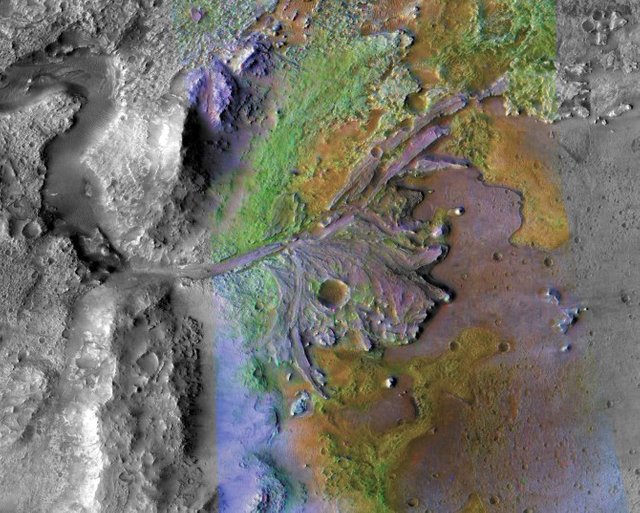They model the climatic conditions in which the rivers and lakes of water could be formed.
The study in Nature Astronomy studies the clays of the red planet to understand a little better how Mars was billions of years ago.

The history of the red planet is full of mysteries. The presence of valleys, basins and deltas, together with the existence of clays and sulphates in surface rocks, suggest that water existed on Mars billions of years ago. However, the scientists faced an unknown that would clash with that primordial scenario of abundant amounts of liquid water on the red planet.
The studies carried out so far did not support the idea that the primitive climate in this world was warm enough to hold liquid water on its surface. What happened then? A group of scientists, including members of NASA, the SETI Institute and the Center for Astrobiology (CAB) of the CSIC-INTA, has published an article in Nature Astronomy where they analyze the conditions that could occur on the red planet for that rivers and lakes of water were formed on Mars.
Researchers have proposed a new climate model that argues that brief warm stages would have coexisted between large cold periods. The first phases, where temperatures of between 25 and 40ºC would have been reached, would be sufficient for liquid water on the surface of Mars, whose erosion caused the formation of valleys, canals and deltas that are still visible on the planet today. Red. "This could mean short periods, from tens of thousands to a few million years, at an average global temperature of 10 ° C on Mars, separated by colder intervals of more than hundreds of millions of years. These high transient temperatures could have been caused by volcanism, changes in obliquity or large impacts, "explains Alberto González Fairén, from the Department of Planetology and Habitability of the CAB and co-author of the work in Nature Astronomy.

At present, the average temperature of Mars is around -61ºC, well below the freezing point of water. In the case that billions of years ago the temperature would have been a little higher, there could have been liquid water on the surface of Mars, giving rise to the valleys, basins and deltas that are still preserved on the red planet. But if the water had been very cold it could not have formed the clays on the surface, since in that case the necessary chemical reactions would occur very slowly, according to detailed in his study. This was the reason why the scientists decided to find out the conditions in which these materials were formed to better understand the climate and the past of Mars. With this objective, the researchers carried out simulations in the laboratory and developed geochemical modeling to limit the original conditions that could have occurred on the red planet.
The team of researchers has classified the clays present in ancient rocks according to the temperature at which they could be formed and their chemical composition. On the one hand would be the clays rich in magnesium (100-400ºC), on the other the smectite clays (20-50ºC) and, finally, the aluminosilicates, originated at -20ºC. Regarding the second group, the scientists emphasize that this temperature interval would have been sufficient to give rise to this type of clays observed on the Martian surface, and that these short warm periods, interspersed between colder eras, could have happened as a consequence of possible impacts and other factors.
Mars was more complex than previously thought
"It seems to me a very interesting article from different points of view, geological, geochemical, mineralogical and climatic", explains Jesús Martínez Frías, head of the Research Group of the CSIC of Meteorites and Planetary Geosciences at the Institute of Geosciences. "Its analysis and interpretation not only affects the importance of the mineralogy and geochemistry of the different types of secondary minerals detected on Mars, mainly clay minerals rich in magnesium, but the authors suggest different aqueous environments in relation to the different paragenesis [association of minerals that have been formed under the same conditions] and mineralogical associations ", comments Hipertextual.
"The model they propose is consistent with the geological observations and emphasizes the greater geodiversity of the red planet during the oldest epoch in which it had liquid water and a greater geological vitality", emphasizes Martínez Frías, director of the Spanish Network of Planetology and Astrobiology (REDESPA) and member of the NASA-MSL, ESA-ExoMars and NASA-Mars2020 missions, which has not participated in the investigation.

"Of special importance to me is the distinction of environments that could have been hydrothermal," says the scientist. This differentiation had already been carried out in the past, but the work published in Nature Astronomy distinguishes different "aqueous paleoenvironmental contexts" that could have formed due to hot water systems and cold or atmospheric aqueous weathering. Martínez Frías also highlights the relationship of the different environments with cold and warm weather, which could have developed transiently. In his opinion, "it is a very interesting study because of the multidisciplinarity of its analysis and results where aspects converge that confirm that Mars, especially in its early stages, was much more complex than previously thought".

Hi, I found some acronyms/abbreviations in this post. This is how they expand:
Downvoting a post can decrease pending rewards and make it less visible. Common reasons:
Submit